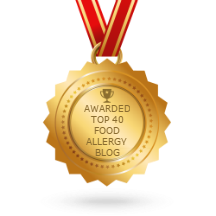Many people realize the seriousness of living with some of the top food allergens like peanuts, tree nuts and shellfish. But few are aware of the challenges of living with the fastest growing allergen: sesame seeds. Here’s what it’s like to manage a food allergy outside of the well-know, well-labelled “Top 8.”
My most recent article appears in The Allergy and Asthma Network’s magazine, Allergy and Asthma Today (Summer 2016 edition). Check out the the rest of this incredibly informative resource: Allergy and Asthma Today (Summer 2016, Vol 14, Issue 2).
It looks amazing in print, check it out: AAT Food Allergy Column – Sesame Summer 2016
Or, read it here:

photo courtsey of Foodista.com
As a toddler, my son was diagnosed allergic to eight different foods: peanuts, tree nuts, dairy, eggs, wheat, soy, corn and sesame seeds. Finding foods manufactured without cross-contamination to nuts is tough; meals that don’t use butter, a challenge; and I dare you to find a commercial meal that doesn’t contain soy. But of all the foods my son has been allergic to, it’s sesame seeds that have caused the most problems. By far. And, of all the food allergies he wishes to outgrow, sesame seeds are at the top of his list.
So, why is something this small causing such big problems?
Of the approximately 160 foods that people are allergic to, just eight are responsible for 90% of all food allergy reactions. In the U.S., those “top 8” foods are:
- Dairy
- Eggs
- Fish
- Shellfish
- Tree nuts
- Peanuts
- Wheat
- Soy
Sesame seeds are number nine.
Sesame allergy is growing at a faster rate in the United States than other food allergies. Many believe this rise may be partially due to the prevalence of international cuisine on American plates.
Because sesame is a less common allergy, it can be difficult to get proper information about sesame ingredients and manufacturers are not required to list it by name on labels.
Sesame is commonly found in Middle Eastern, Indian and Asian cuisines; it offers protein in vegetarian dishes. Sesame shows up in salad dressing, marinades, granola bars and as an ingredient in (not just on) hamburger buns and baked goods. It may also be found in beauty products such a lip balms and lotions.
Our family allergist described sesame seeds as a cousin allergy to the peanut. Individuals allergic to sesame are often also allergic to peanuts and tree nuts. Like nut allergies, allergic reactions to sesame seeds can be severe with symptoms including difficulty breathing, throat swelling and anaphylaxis. Those with a sesame allergy should carry an epinephrine auto-injector to protect them against accidental exposure.
The U.S. Food and Drug Administration (FDA) requires manufacturers to highlight the top eight allergens. Whereas whey, butter and cream must be labeled as “milk” somewhere on an ingredient list, sesame seeds may be listed under a variety of names [see below] including some generic terms like “flavoring,” “spices,” and “seasoning.”
If you are allergic to sesame seeds, you may already know to look for some of the following alternative names for them:
- benne, bene seed, benniseed
- gingilly, gingilly oil
- sesamol, sesamolina, sesamum indicum
- sim sim
- tahini
- til
- vegetable oil
- natural flavoring
- spices
- seasoning
When in doubt, call the manufacturer should help determine if a product is allergy safe.
Given the dramatic increase in the number of sesame seed allergies in the United States, it may benefit the FDA to get ahead of the trend and follow their counterparts in Canada and Europe by adding a requirement to list sesame seeds as well.











[…] Sesame: the 9th Food Allergen? explains the rise in sesame allergy and the difficulty faced by those who are allergic. When the Director of the Division of Pediatric Allergy and Immunology at Johns Hopkins University School of Medicine, Dr. Robert Wood spoke to WebMD in 2012, he believed sesame seed allergy was so prevalent that it had likely climbed to the 6th or 7th most common allergen in the U.S. […]
[…] seed allergy (and any allergy outside of the Top 8) is challenging. To get a sense of it, read Sesame: The 9th Food Allergen? originally published in Allergy & Asthma Today […]
[…] For more information on sesame seed allergies, please see Sesame: The 9th Food Allergen? […]
[…] H.R. 2117: Food Allergy Safety, Treatment, Education and Research (FASTER) Act Requires that sesame be added to the current list of allergens that manufacturers are required to label for. The bill would also provide the CDC funding to conduct data on allergy prevalence. My take: Sesame is the 9th most common allergen (and one of the fastest growing allergies in terms of prevalence) and it’s a particularly difficult one to avoid. Ground into flour and paste, used as oil in beauty products, in addition to whole seeds, current labeling guidelines allow for sesame to be hidden in ingredient lists under general terminology like “spices,” “natural flavors,” and “seasoning.” Customers want transparency in their food and beauty products. And, labeling for sesame would bring the US closer to the [more thorough and higher] standards set in the UK, EU, Canada and Australia. For more information on sesame seed allergies, please see Sesame: The 9th Food Allergen? […]
[…] or not. [Read here for more information on the challenges of living with a sesame seed allergy: Sesame: The 9th Food Allergen?]. Patients and caregivers need more transparency and advocates have been asking the government for […]
[…] [Read here for more information on the challenges of living with a sesame seed allergy: Sesame: The 9th Food Allergen?]. Patients and caregivers need more transparency and advocates have been asking the government for […]
[…] For more information on sesame seed allergies, please see Sesame: The 9th Food Allergen? […]
[…] Sesame: the 9th Food Allergen? […]